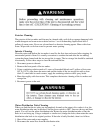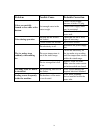
14
Condenser
Compressor
to purge the water remaining in the water tank, removing all impurities and sediment.
This allows the machine to make clear ice cubes and keep mineral build-up at a
minimum. Then the water pump stops. When the hot gas valve opens, it allows hot gas
to go directly to the evaporator. The gas warms the evaporator, causing the cubes to slide
off the evaporator and into the storage bin. The freeze cycle will restart when all the
cubes drop into the bin.
How the machine uses water:
The ice maker begins with a fixed charge of water that is contained in the water tank. As the
water flows to the freezing evaporator surface, the water freezes and sticks to the ice cube molds.
During the ice-making process, fresh water enters the water tank continuously as the water from
the tank freezes continuously on the evaporator.
Normal Sounds
Your new ice maker may make sounds that are unfamiliar to you. Most of the new sounds are
normal. Hard surfaces like the floor and walls can amplify the sounds. The following describes
the kinds of sounds that might be new to you and what may be causing them.
·
Rattling noises may come from the flow of the refrigerant or the water line. Items stored on the
top of the ice maker can also make noises.
·
The high-efficiency compressor may make a pulsating or high-pitched sound.
·
Running water may make a splashing sound.
·
You may hear air being forced over the condenser by the condenser fan.
·
During the harvest cycle, you may hear the sound of ice cubes falling into the ice storage bin.
Preparing the Ice Maker for Long Storage
If the ice maker will not be used for a long time, or it is to be moved to another place, it will be
necessary to drain water from the system.
1. Shut off the water supply at the main water source.
2. Disconnect the water supply pipe from the water inlet.
Water
pump
Fan
motor
Hot gas valve
Water tank
Water
inlet
Evaporator


















